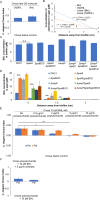Biofilm matrix cloaks bacterial quorum sensing chemoattractants from predator detection
- PMID: 35034106
- PMCID: PMC9038794
- DOI: 10.1038/s41396-022-01190-2
Biofilm matrix cloaks bacterial quorum sensing chemoattractants from predator detection
Abstract
Microbes often secrete high levels of quorum sensing (QS) autoinducers into the environment to coordinate gene expression and biofilm formation, but risk detection and subsequent predation by bacterivorous predators. With such prominent signaling molecules acting as chemoattractants that diffuse into the environment at alarmingly high concentrations, it is unclear if bacterial cells can mask their chemical trails from predator detection. Here, we describe a microbial-based anti-detection adaptation, termed as "biofilm cloak", where the biofilm prey produced biofilm matrix exopolysaccharides that "locked" and reduced the leaching of autoinducers into the milieu, thereby concealing their trails to the detection by the bacterivorous Caenorhabditis elegans nematode. The exopolysaccharides act as common good for the non-producers to hide their autoinducers from predator detection. Deficiency in chemosensory gene odr-10 in mutant animals abrogated their ability to detect autoinducers and migrate toward their prey in a directed manner, which led to lower population growth rate of animals. Hence, restriction of bacterial communication activities to the confinements of biofilms is a novel approach for predator evasion, which plays a fundamental role in shaping ecological dynamics of microbial communities and predator-prey interactions.
© 2022. The Author(s), under exclusive licence to International Society for Microbial Ecology.
Conflict of interest statement
The authors declare no competing interests.
Figures





References
-
- Jessup CM, Forde SE, Bohannan BJM. Microbial experimental systems in ecology. In: Desharnais RA, editor. Advances in ecological research, Vol. 37. Elsevier, USA: Academic Press; 2005. p. 273–307.
-
- Otto G. Arresting predators. Nat Rev Microbiol. 2020;18:675. - PubMed

